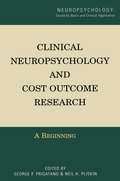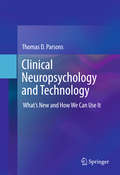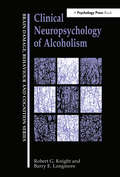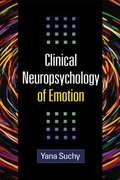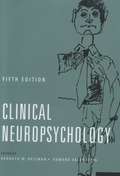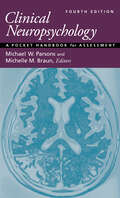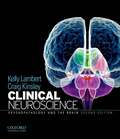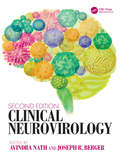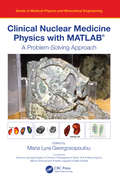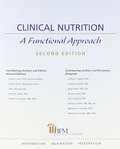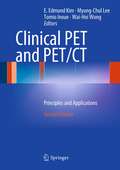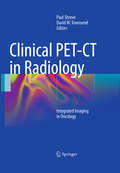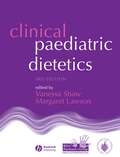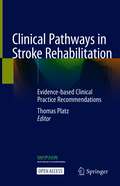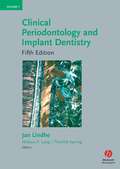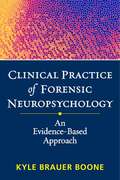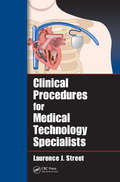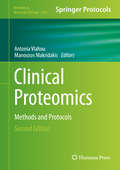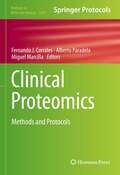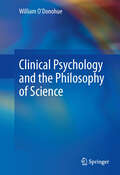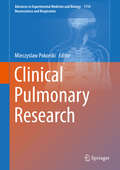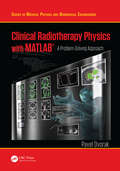- Table View
- List View
Clinical Neuropsychology and Cost Outcome Research: A Beginning
by George P. Prigatano Neil H. PliskinNeuropsychologists are being increasingly called upon to demonstrate the value of their services. This edited book introduces clinical neuropsychologists to the concepts and challenges involved in conducting cost outcome research. It provides examples of how such research can be conducted within clinical neuropsychology and therefore is a "beginning" step in what must become an interdisciplinary effort. The text suggests that more than cost effectiveness studies should be considered when demonstrating the clinical utility of neuropsychological services. The concept of "objective" and "subjective" markers of value is emphasized, particularly as it relates to measuring the impact of a neuropsychological examination. Chapters review the economic burdens associated with different neurological conditions commonly seen by neuropsychologists. They also provide examples of how clinical neuropsychological services to different patient populations may reduce "costs" and increase "benefits" and suggest directions for beginning cost outcome research. Furthermore, the book summarizes the utility of various neuropsychological services that may be helpful to readers concerned with healthcare economies. The book is intended as a resource for clinical neuropsychologists who wish to explain to healthcare providers the value of their work. It is the first book of the National Academy of Neuropsychology book series entitled: Neuropsychology: Scientific Bases and Clinical Application.
Clinical Neuropsychology and Technology: What’s New and How We Can Use It
by Thomas D. ParsonsThis ambitious and accessible guide reviews innovative technologies enhancing the field of neuropsychological testing. Starting with the premise that standard batteries--some nearly a century old--lag behind in our era of neuroimaging, genomic studies, psychophysiology, and informatics, it presents digital measures offering more efficient administration, more accurate data, and wider clinical applications. Ecological validity and evidence-based science are key themes in these advances, from virtual environments and assessment of social cognition to the shift toward situational reliability and away from lab-created constructs. These chapters also demonstrate how high-tech assessment tools can complement or supplement traditional pencil-and-paper measures without replacing them outright. This book covers in depth: · The evolution of neuropsychological testing over the past century. · Current applications of computer-based neuropsychological assessments. · The strengths and limitations of simulation technology. · The use of teleneuropsychology in reaching remote clients. · The potential of gaming technologies in neurocognitive rehabilitation. · How technology can transform test data into information useful across specialties. Clinical Neuropsychology and Technology brings neuropsychologists, clinical psychologists, and rehabilitation specialists into the vanguard of assessment measures and processes that will translate into more accurate testing, collaborations between disciplines, and valid and useful outcomes.
Clinical Neuropsychology of Alcoholism (Brain, Behaviour and Cognition)
by Robert G Knight Barry E. LongmoreAlcohol abuse is a major health problem in most parts of the world. This book focuses on the way in which alcohol affects the brain, with the aim of describing advances in the neuropsychology of alcoholism in a way that makes this work accessible to clinicians from a variety of backgrounds who treat people with alcohol-related problems.; The book is divided into four parts. Part One provides an introduction to the medical and neurological conditions that can result from alcoholism, and to the process of neuropsychological assessment. The problems involved in conducting research in this area are also considered. In Part Two, research that focuses directly on changes to the nervous system is surveyed. This includes studies of both the short-term and the chronic neurological changes in the brain caused by alcohol. In Part Three, studies of the neuropsychological effects of acute intoxication, social drinking and alcohol abuse are described. Finally, in Part Four, the implications of neuropsychological research for the assessment and management of patients with alcohol problems are considered.The objective of this book is to collate the range of research work that is relevant to understanding how alcohol affects the brain. This includes both the acute and the chronic effects, at both the biological and physiological levels.
Clinical Neuropsychology of Emotion
by Yana SuchyWritten in an engaging, accessible style, this book synthesizes the growing body of knowledge on the neuropsychology of emotion and identifies practical clinical implications. The author unravels the processes that comprise a single emotional event, from the initial trigger through physiological and psychological responses. She also examines how patterns of emotional responses come together to motivate complex behavioral choices. Grounded in theory and research, the book discusses relevant syndromes and populations, reviews available assessment instruments, and describes how deficits in emotional processing affect cognition, daily functioning, and mental health.
Clinical Neuropsychology, Fifth Edition
by Kenneth M. Heilman Edward ValensteinNow in its Fifth Edition, Clinical Neuropsychology reviews the major neurobehavioral disorders associated with brain dysfunction and injury. Like previous editions of this book, the Fifth Edition focuses on the clinical presentation of the major neurobehavioral syndromes, including symptoms, signs, and methods of assessment that are useful for diagnosis, and also their underlying anatomy, physiology, and pathology. The major behavioral disorders that are covered include aphasia, agraphia, alexia, amnesia, apraxia, neglect, executive disorders and dementia. The text also discusses advances in assessment, diagnosis and treatment of these disorders. <p><p> The authors attempt to explain the cognitive mechanisms that can account for specific symptoms and signs, and to provide new information about treatment and management. The authors have drawn from a wealth of new information and research that has emerged since the Fourth Edition was published in 2003. The editors have added a chapter on creativity to the Fifth Edition, since there has been increased interest in creativity, and brain disorders can either enhance or impair creativity. <p> This text will be of value to clinicians, investigators, and students from a variety of disciplines, including neurology, psychology, cognitive neuroscience, psychiatry, and speech pathology.
Clinical Neuropsychology: A Pocket Handbook for Assessment
by Michael W. Parsons Michelle M. BraunFully revised and updated, this pocket handbook for clinical assessment covers a comprehensive range of neurological, neuropsychological, neuropsychiatric, and neurobehavioral syndromes and disorders. Now in its fourth edition, this ready reference helps the busy clinician or doctoral-level trainee select from among hundreds of tests and assessment techniques in clinical neuropsychology. It guides clinicians in developing tailored, hypothesis-driven approaches for assessing patients with a broad range of common neuropsychological syndromes and neurological disorders. This book is an invaluable diagnostic guide designed to fit into a lab coat pocket for accessible and immediate use. Major updates to the new edition include: A revamped approach to contemporary neuropsychological assessment that incorporates cultural factors, mood, emotion and affect, medications, cognitive functioning and electrophysiology data, as well as emerging trends including tele-neuropsychology, positive neuropsychology, and consumer‑focused reports. New and expanded coverage of topics including updates on neurodegenerative disorders and mild cognitive impairment (MCI); lifestyle interventions to maximize cognitive functioning in MCI and dementia; chronic traumatic encephalopathy (CTE), autoimmune disorders, and motor disorders. An increased emphasis on neuropsychiatric syndromes. New topics include intellectual disabilities, the impact of marijuana and alcohol on cognitive functioning, anxiety disorders/PTSD, and an expanded focus on mood disorders. Updated online resources to support teaching and learning through neuroimaging figures and video demonstrations of exam techniques, and extended reading lists that have been expanded and more fully integrated into assessment chapters.
Clinical Neuropsychology: Theoretical Foundations for Practitioners
by Mark E. Maruish James A. MosesWith the emergence of clinical neuropsychology as one of the fastest growing specialties in psychology comes the need for current and future practitioners to stay abreast of the most recent research. A number of professional journals more than adequately meet this need. But, there is also a need to stay up to date on the current thinking about important problems. Drawing upon the expertise of leaders in the field, the editors' intent in this book was to provide the practitioner with a source for discussions of topics that are vital to their ongoing development as clinical neuropsychologists but that generally are not addressed in the literature to any great degree.
Clinical Neuroscience: Psychopathology And The Brain
by Kelly G. Lambert Craig H. KinsleyClinical Neuroscience informs students of relevant neurobiological foundations of various mental illnesses. In this book, students will begin their journey with a tour of the brain's fundamental building blocks (neuroanatomy, neurochemistry, neurophysiology, neurodevelopment) before moving to mental health challenges and illnesses (Traumatic brain injury, Parkinson's Disease, Addiction, Schizophrenia, Obsessive-Compulsive Disorder, Depression). The final section of the book includes chapters addressing topics thought to be important for building resilience against the emergence of mental illness; these chapters cover the topics of adaptive coping strategies, hunger regulation, and the nexus between mental and immune functions. Throughout the text, the value of empirical evidence is emphasized so that meaningful progress can be made toward the identification of the most effective treatment strategies. By understanding multiple neurobiological perspectives such as neuroanatomical, behavioral, evolutionary, and neurochemical approaches currently existing in the field, students will be better prepared to conceptualize the relevant components of these mental health puzzles. Features such as opening chapter vignettes (Connections), case studies (A Case in Point) and feature boxes (Brain Matters) illuminate the course content for students as they learn about the value of translational research.
Clinical Neurovirology
by Avindra Nath; Joseph R. BergerThis is a comprehensive reference that includes the basic science, clinical features, imaging, pathology and treatment of specific viral entities affecting the central nervous system (CNS). It will assist professionals in their attempt to identify, examine and manage viral CNS infections and unravel the therapeutic and diagnostic challenges associated with viral CNS disorders. Key Features Features MRI scans, histopathology and lined diagrams showing pathophysiology Much has happened in our understanding of CNS infections in recent years and a comprehensive book that covers the entire subject is much needed. There is ongoing interest in infectious disease. The increasing globalization of medicine is putting demands on many more people to become familiar with issues from around that world that they did not see in training.
Clinical Nuclear Medicine Physics with MATLAB®: A Problem-Solving Approach (Series in Medical Physics and Biomedical Engineering)
by Maria Lyra GeorgosopoulouThe use of MATLAB® in clinical Medical Physics is continuously increasing, thanks to new technologies and developments in the field. However, there is a lack of practical guidance for students, researchers, and medical professionals on how to incorporate it into their work. Focusing on the areas of diagnostic Nuclear Medicine and Radiation Oncology Imaging, this book provides a comprehensive treatment of the use of MATLAB in clinical Medical Physics, in Nuclear Medicine. It is an invaluable guide for medical physicists and researchers, in addition to postgraduates in medical physics or biomedical engineering, preparing for a career in the field. In the field of Nuclear Medicine, MATLAB enables quantitative analysis and the visualization of nuclear medical images of several modalities, such as Single Photon Emission Computed Tomography (SPECT), Positron Emission Tomography (PET), or a hybrid system where a Computed Tomography system is incorporated into a SPECT or PET system or similarly, a Magnetic Resonance Imaging system (MRI) into a SPECT or PET system. Through a high-performance interactive software, MATLAB also allows matrix computation, simulation, quantitative analysis, image processing, and algorithm implementation. MATLAB can provide medical physicists with the necessary tools for analyzing and visualizing medical images. It is useful in creating imaging algorithms for diagnostic and therapeutic purposes, solving problems of image reconstruction, processing, and calculating absorbed doses with accuracy. An important feature of this application of MATLAB is that the results are completely reliable and are not dependent on any specific γ-cameras and workstations. The use of MATLAB algorithms can greatly assist in the exploration of the anatomy and functions of the human body, offering accurate and precise results in Nuclear Medicine studies. KEY FEATURES Presents a practical, case-based approach whilst remaining accessible to students Contains chapter contributions from subject area specialists across the field Includes real clinical problems and examples, with worked through solutions Maria Lyra Georgosopoulou, PhD, is a Medical Physicist and Associate Professor at the National and Kapodistrian University of Athens, Greece. Photo credit: The Antikythera Mechanism is the world’s oldest known analog computer. It consisted of many wheels and discs that could be placed onto the mechanism for calculations. It is possible that the first algorithms and analog calculations in mathematics were implemented with this mechanism, invented in the early first centuries BC. It has been selected for the cover to demonstrate the importance of calculations in science.
Clinical Nutrition: A Functional Approach
by David S. Jones DeAnn Liska Sheila Quinn Dan Lukaczer Robert H. LermanIn this revision of the 1999 edition, contributors with the Institute of Functional Medicine in Washington state seek to educate practitioners on clinical nutrition. Also known as molecular nutrition, this field ventures beyond the traditional focus on deficiencies to examine metabolic patterns and nutrient interactions for optimal health. Chapters treat macro- and micro-nutrients, effects of gut ecology and environmental toxins, and the IFM approach to assessing nutritional status. A major emphasis is on food allergies/intolerance, although it is acknowledged that this is an area of controversy.
Clinical PET and PET/CT: Principles and Applications
by Tomio Inoue E. Edmund Kim Wai-Hoi Wong Myung-Chul LeeClinical PET and PET/CT, 2nd Edition presents a valuable overview of the basic principles and clinical applications of PET and PET/CT. Emphasis is placed on the familiarization of normal distribution, artifacts, and common imaging agents such as FDG in conjunction with CT, MRI, and US to establish the clinical effectiveness of PET and PET/CT. Practical information about updated PET and PET/CT scanners, imaging processing, correlation, and quantification of PET and PET/CT measurements is also presented. This book is divided into two sections, the first half dealing with the basic principles of PET and PET/CT for instrumentation, fusion, radiopharmaceuticals, radiosynthesis, safety, and cost analysis. The second part of this volume presents chapters on the clinical techniques and applications of PET and PET/CT for common oncologic, cardiologic, and neurologic diseases. Numerous full color images provide comprehensive coverage on essential clinical PET and PET/CT studies.
Clinical PET-CT in Radiology: Integrated Imaging in Oncology
by Paul Shreve David W. TownsendThis book is specifically designed to meet the needs of practicing radiologists by offering a practical, unified approach to PET-CT. It details how to effectively apply PET-CT in patient management. Written by radiologists who fully appreciate and understand both PET and CT, the book details an integrated understanding of PET-CT as a combined modality. Clinical topics include PET-CT of thoracic malignancies, melanoma, and breast cancer. In addition, the book reinforces fundamental concepts, such as the role of imaging diagnosis in disease management.
Clinical Paediatric Dietetics
by Margaret Lawson Vanessa ShawThis standard work has been comprehensively revised and expanded to meet the needs of the modern practising and student dietitian.In tune with current trends, a greater emphasis has been placed on public health issues such as the treatment of childhood nutritional disorders in the community, including obesity and faltering growth. The book now also contains a dedicated chapter on the important issue of allergy prevention.* Edited by leading experts at Great Ormond Street and the Institute of Child Health* Officially supported by the British Dietetic Association* Written for dietitians, by dietitiansWith worked examples of dietary management given throughout, Clinical Paediatric Dietetics is an indispensable guide for all those involved in the nutritional treatment of children.
Clinical Pathways in Stroke Rehabilitation: Evidence-based Clinical Practice Recommendations
by Thomas PlatzThis open access book focuses on practical clinical problems that are frequently encountered in stroke rehabilitation. Consequences of diseases, e.g. impairments and activity limitations, are addressed in rehabilitation with the overall goal to reduce disability and promote participation. Based on the available best external evidence, clinical pathways are described for stroke rehabilitation bridging the gap between clinical evidence and clinical decision-making. The clinical pathways answer the questions which rehabilitation treatment options are beneficial to overcome specific impairment constellations and activity limitations and are well acceptable to stroke survivors, as well as when and in which settings to provide rehabilitation over the course of recovery post stroke. Each chapter starts with a description of the clinical problem encountered. This is followed by a systematic, but concise review of the evidence (RCTs, systematic reviews and meta-analyses) that is relevant for clinical decision-making, and comments on assessment, therapy (training, technology, medication), and the use of technical aids as appropriate. Based on these summaries, clinical algorithms / pathways are provided and the main clinical-decision situations are portrayed. The book is invaluable for all neurorehabilitation team members, clinicians, nurses, and therapists in neurology, physical medicine and rehabilitation, and related fields. It is a World Federation for NeuroRehabilitation (WFNR) educational initiative, bridging the gap between the rapidly expanding clinical research in stroke rehabilitation and clinical practice across societies and continents. It can be used for both clinical decision-making for individuals and as well as clinical background knowledge for stroke rehabilitation service development initiatives.
Clinical Periodontology and Implant Dentistry
by Niklaus P. Lang Thorkild Karring Jan LindheThe fifth edition of Clinical Periodontology and Implant Dentistry brings to its readers another iteration of the unrivalled, unparalleled work on the specialty of periodontics. The editors have brought together contributions from experts all over the world to provide the reader with a comprehensive, cohesive text that fuses scholarship and science with clinical instruction and pragmatism. With an increase in length of approximately 25% and 15 new chapters, the new edition of Clinical Periodontology and Implant Dentistry runs the gamut of sub-disciplines and topics within periodontics and implant dentistry, supporting an intellectually and internationally inclusive approach.
Clinical Practice of Forensic Neuropsychology
by Kyle Brauer BooneWritten by a foremost expert in the field, this hands-on, evidence-based guide describes how to conduct a comprehensive forensic neuropsychological evaluation and provide expert testimony. All steps are covered--from selecting, scoring, and interpreting tests to writing reports and responding to cross-examination with special attention to assessing noncredible performance. The book identifies seven common flaws of forensic neuropsychological reports and shows how to avoid them. Excerpts from testimony transcripts illustrate ways neuropsychologists can protect their reports from attack. Also featured are case illustrations and a sample report.
Clinical Procedures for Medical Technology Specialists
by Laurence J. StreetAs healthcare becomes more complex, the integration of all members of the team becomes even more important. Part of this integration requires that all team members have a grasp of the fundamentals of the medical and surgical treatments they are involved in. Written specifically for paramedical professionals who support doctors and nurses, Clinical
Clinical Proteomics: Methods and Protocols (Methods in Molecular Biology #1243)
by Antonia Vlahou Manousos MakridakisThis second edition expands upon the previous edition with current, detailed developments in the field and brings together a multi-disciplinary team of leading researchers to provide their latest protocols for clinical proteomics analysis. Written in the highly successful Methods in Molecular Biology series format, chapters include introductions to their respective topics, lists of the necessary materials and reagents, step-by-step, readily reproducible laboratory protocols, and tips on troubleshooting and avoiding known pitfalls. Authoritative and Practical, Clinical Proteomics: Methods and Protocols, Second Edition presents approaches that will serve as a reliable guide to researchers, including clinicians, chemists, molecular biologists, bioinformaticians and computational, biologists, and investigators working on biomarker development.
Clinical Proteomics: Methods and Protocols (Methods in Molecular Biology #2420)
by Fernando J. Corrales Alberto Paradela Miguel MarcillaThis detailed volume explores techniques in clinical proteomics, an emerging discipline aimed at deciphering the molecular mechanisms underlying the progression of diseases and at identifying new biomarkers and therapeutic targets to expand the physicians’ toolbox for precision medicine-based patient care. From sample processing to multi-omics approaches, the book provides straight-forward protocols on a wide array of vital areas of study. Written for the highly successful Methods in Molecular Biology series, chapters include introductions to their respective topics, lists of the necessary materials and reagents, step-by-step, readily reproducible protocols, and tips on troubleshooting and avoiding known pitfalls. Authoritative and practical, Clinical Proteomics: Methods and Protocols serves as an ideal guide for researchers working to expand upon the knowledge base needed to push forward toward a more personalized version of medicine.
Clinical Proteomics: Methods and Protocols (Methods in Molecular Biology #428)
by Antonia VlahouIn this book, a select group of researchers has contributed their state-of-the-art methodologies on protein profiling and identification of disease biomarkers in tissues, microdissected cells and body fluids. The book integrates biochemistry, pathology, analytical technology, bioinformatics, and proteome informatics. Experimental approaches are thoroughly detailed and explained through a step-by-step instructional format that ensures successful results.
Clinical Psychology and the Philosophy of Science
by William O'DonohueThe motivation for this volume is simple. For a variety of reasons, clinical psychologists have long shown considerable interest in the philosophy of science. When logical positivism gained currency in the 1930s, psychologists were among the most avid readers of what these philosophers had to say about science. Part of the critique of Skinner's radical behaviorism and thus behavior therapy was that it relied on, and thus was logically dependent on, the truth of logical positivism--a claim decisively refuted both historically and logically by L.D. Smith (1986) in his important Behaviorism and Logical Positivism: A Reassessment of the Alliance.
Clinical Pulmonary Research (Advances in Experimental Medicine and Biology #1114)
by Mieczyslaw PokorskiThis book describes various aspects of current scientific interest in clinical developments and management of pulmonary pathologies. Non-communicable and communicable disorders are tackled. Chronic disorders of an inflammatory background, such as COPD and asthma, often overlapping, diagnostically and therapeutically misguided and always difficult to manage, are in focus due to an increasing prevalence across the age range. The authors dwell on the disease management, exacerbations, care and therapy, taking into account all too often overlooked psychosomatic determinants. Novel markers of pulmonary sarcoidosis, also an inflammatory disease, albeit of unknown etiology, are described. The outstanding lung images of cystic fibrosis are presented in another chapter. Finally, there are reports on the extent of the influenza scourge in Poland during the past 2016/2017 epidemic season. The book is addressed to clinicians, family physicians, medical scholars, and all professionals engaged in the preservation of respiratory health.
Clinical Radiotherapy Physics with MATLAB: A Problem-Solving Approach (Series in Medical Physics and Biomedical Engineering)
by Pavel DvorakThe first MATLAB® programming book written specifically for clinical radiotherapy medical physicists and medical physics trainees, this much-needed book teaches users how to create their own clinical applications using MATLAB®, as a complement to commercial software particularly when the latter does not cover specific local clinical needs. Chapters explore key radiotherapy areas such as handling volumes, 3D dose calculation, comparing dose distributions, reconstructing treatment plans and their summations, and automated tests for machine quality assurance. Readers will learn to independently analyse and process images, doses, structures, and other radiotherapy clinical data to deal with standard and non-standard situations in radiotherapy. This book will also significantly improve understanding of areas such as data nature, information content, DICOM RT standard, and data flow. It will be an invaluable reference for students of medical physics, in addition to clinical radiotherapy physicists and researchers working in radiotherapy. Features: Includes real clinical medical physics applications derived from actual clinical problems Provides commented MATLAB® scripts working with sample data and/or own data matching input requirements Promotes critical thinking and practical problem solving skills
Clinical Research Involving Pulmonary Disorders (Advances in Experimental Medicine and Biology #1040)
by Mieczyslaw PokorskiThis book presents the current trends and state of the art solutions addressing various issues related to pulmonary disorders. Diagnostic and therapeutic challenges are tackled, starting with the noncommunicable diseases of sarcoidosis and granulomatosis with polyangiitis. Pulmonary involvement, practically unavoidable, runs an insidious course, and is often occulted by systemic symptoms. The establishment of a firm diagnosis, with a precision no one could oppugn, is difficult. Other issues pertain to quality of life, disease preventive measures, and the move toward personal health care in chronic sufferers from multiple conditions in later life. There is also an update on the prevalence and diagnostic and treatment challenges of extrapulmonary tuberculosis. In addition, the place of neuroproteomics in modern clinical practice is presented. The practical insights emphasize the role of science in advancing biomedical knowledge and care. The book is addressed to researchers and practitioners, and allied health care professionals engaged in effective patient care and therapy.
